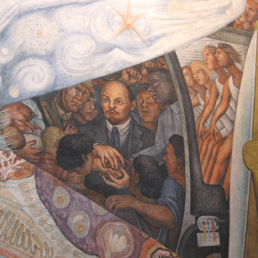
“In destroying my paintings the Rockefellers have committed an act of cultural vandalism.” – Diego Rivera
In 1932, Diego Rivera was commissioned to create a mural in the middle of Manhattan’s Rockefeller Center. He was in the midst of a prolific period, having just enjoyed a successful retrospective at the MoMA in 1931 and having completed mural projects in San Francisco and Detroit. But by 1934, his mural was chiselled off the wall, and was lost forever. In the latest article in our “Stories Of Iconic Artworks” series, we uncover the story of a revolutionary artist rebelling against his critics and employers, which lead to the dramatic removal of an incredible masterpiece.
Diego Rivera and The Rockefeller Center Commission
When Diego Rivera was commissioned by Nelson D. Rockefeller to paint the mural, the Rockefeller family was well aware of his leftist politics. Yet they were eager to have the best works of art by the best artists of the time. They were interested in pursuing both the inherent artistic and commercial value of art, and believed Rivera to be an excellent investment and one of the most important artists of his day. Rockefeller wanted a painting that would make people pause and think, something to summarise the era, so he gave Rivera a theme: “Man at the Crossroads Looking with Hope and High Vision to the Choosing of a New and Better Future.” This was in line with the theme of the Rockefeller Center, (the massive real estate complex at the heart of the Rockefeller’s Empire and public profile), which was “New Frontiers.” Rivera was asked to portray a man at a crossroads, looking ahead with uncertainty but with optimism and vision, choosing a course which would lead to a new and better future. A three-page contract stated exactly what was expected of Rivera. Yet it soon became clear that Rivera and the Rockefellers had a very different vision of what this “new and better future” should look like.



“If someone buys the Sistine Chapel, does he have the authority to destroy it?” – Diego Rivera
From Sketch to Mural
Initially, Rivera presented a sketch that aligned with the theme and abided by the contract he had signed. His proposal was a 63-foot-long portrait of workers, embracing the multi-faceted components of modern life of industry, science, socialism and capitalism. In the original sketch for the mural, Rivera depicted three men clasping hands in the middle – a soldier, a worker and a peasant, representing the three elements that Rivera believed human society was fundamentally composed of.
However, the eventual execution differed markedly from this sketch. In New York, he was confronted and provoked by leftist organisations and communist groups, who disagreed with him taking on a commission for the Rockefellers, and who felt that by doing so he was betraying his communist sensibilities. The story goes that when the World Telegram ran the headline “Rivera paints Scenes of Communist Activity and John D. Jr. Foots the Bill,” Rivera had enough and decided to add a portrait of Lenin to the mural. “If you want communism, I will paint communism,” he said. On top of this, Rivera apparently added an unflattering portrait of Rockefeller which was deemed inappropriate. The Rockefellers were displeased and Rivera was given two options: either he removed the offending portraits of Lenin and Rockefeller, or the mural itself would be removed. Since Rivera had convinced the Rockefellers to let him paint a fresco, instead of painting on canvas, the mural could not simply be moved. Rivera declared he would rather see the work destroyed than mutilated by altering it, and he was fired from the commission. The building managers paid him his full fee of $21,000 and he was banned from the site. The mural was then hidden behind a drape, and the night before Rivera would have completed it, on 10 February 1934, the mural was chiselled off the wall. Rivera’s mural was replaced by a larger mural by Catalan artist Jose Maria Sert, titled “American Progress.” This mural can still be seen in Rockefeller Center to this day.

Diego Rivera’s New Mural: “Man, Controller of the Universe”
Fortunately, Rivera had anticipated trouble with his commission and had told his assistant Lucienne Bloch to take documentary photographs of the mural. Her black and white photos are the only images that remain of the original work. Rivera used these photographs to repaint the a variant of the composition in Mexico that same year, where he named it “Man, Controller of the Universe.”
The mural brings together a vast variety of scenes and symbols, ranging from science to social life. At the centre of the mural, a workman is depicted controlling machinery. A giant hand in the foreground holds an orb that represents atoms and dividing cells in chemical and biological generation processes. Discoveries that were made possible by the telescope and the microscope are also depicted. To the left of the orb, scenes of modern life are shown – women playing cards and smoking, for example. Right of the orb, Lenin is depicted holding hands with a group of workers from all different ethnicities. On the top left of the mural, scenes of war are shown while people on the upper right seem to be reacting to these violent scenes of war. Rivera also painted classical statues, one of which is a headless Caesar, which is meant to represent science replacing superstition, and the rise of liberated workers.
After all the turmoil in New York, Rivera got his way and managed to create the mural he had intended to create, Lenin and all. “Man, Controller of the Universe” can still be seen today at the Museo del Palacio de Bellas Artes in Mexico City.
